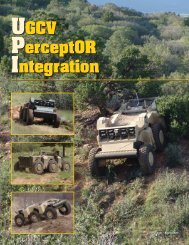CRUSHER - National Robotics Engineering Consortium - Carnegie ...
CRUSHER - National Robotics Engineering Consortium - Carnegie ...
CRUSHER - National Robotics Engineering Consortium - Carnegie ...
You also want an ePaper? Increase the reach of your titles
YUMPU automatically turns print PDFs into web optimized ePapers that Google loves.
<strong>CRUSHER</strong><br />
UNMANNED GROUND<br />
COMBAT VEHICLE<br />
THE VEHICLE<br />
The Crusher vehicle was created as<br />
part of the UPI program at the <strong>National</strong><br />
<strong>Robotics</strong> <strong>Engineering</strong> Center (NREC) of<br />
<strong>Carnegie</strong> Mellon University. The UPI<br />
program features quarterly field experiments<br />
that assess the capabilities of<br />
large scale, unmanned ground vehicles<br />
(UGV) operating autonomously in a<br />
wide range of complex, off-road terrains.<br />
UPI's aggressive mobility, autonomy<br />
and mission performance objectives<br />
required two additional test platforms<br />
that could accommodate a variety of<br />
mission payloads and state of the art<br />
autonomy technology. Crusher represents<br />
the next generation of<br />
the original Spinner<br />
platform,<br />
Crusher’s suspension system allows it to maintain high offroad speeds across extreme terrains.<br />
the world's first greater-than-6-ton,<br />
cross-country UGV designed from the<br />
ground up. Crusher offers more mobility,<br />
reliability, maintainability and flexibility<br />
than Spinner, at 29 percent less weight.<br />
TOMORROW'S TECHNOLOGY<br />
AVAILABLE TODAY<br />
Crusher has a new space frame hull<br />
designed by CTC Technologies and<br />
made from high-strength aluminum tubes<br />
and titanium nodes. A suspended and<br />
shock-mounted skid plate made from<br />
high-strength steel allows Crusher to<br />
shrug off massive, below-hull strikes<br />
from boulders and tree stumps. The nose<br />
was completely redesigned for Crusher<br />
to sustain normal impacts with<br />
trees and brush while also<br />
absorbing the impact of major<br />
collisions.<br />
Suspensions designed by Timoney support<br />
30 in. of travel with selectable stiffness<br />
and reconfigurable ride height.<br />
Crusher can comfortably carry over<br />
8000 lbs. of payload and armor.<br />
Crusher's hybrid electric system allows<br />
the vehicle to move silently on one battery<br />
charge over miles of extreme terrain.<br />
A 60kW turbo diesel engine maintains<br />
charge on the high-performance<br />
SAFT-built lithium ion battery module.<br />
Engine and batteries work intelligently<br />
to deliver power to Crusher's 6-wheel<br />
motor-in-hub drive system built around<br />
UQM traction motors.<br />
By mid 2006, NREC will integrate its<br />
latest automation technology onto both<br />
Crusher vehicles. A combination of ladar<br />
and camera systems allow the vehicles<br />
to dynamically react to obstacles and<br />
travel through mission waypoints<br />
spaced over a kilometer apart. The use<br />
of overhead data via terrain data<br />
analysis will continue to be<br />
utilized for global planning.<br />
Over the next year<br />
these two vehicles will<br />
analyze, plan, and<br />
execute mobility missions<br />
over extreme terrains<br />
without any human<br />
interaction at all.



